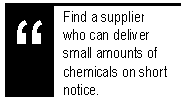
|
Effective waste minimization begins with effective purchasing decisions. The idea is to buy only what you need, because if you don’t buy it, you don’t have to get rid of it.
The American Chemical Society estimates that unused chemicals can constitute up to 40% of the wastes generated by a lab. In many schools, unused chemicals have not made it into the waste stream—yet. These schools have an inventory of unused chemicals left over by former teachers or researchers. These chemicals can be a problem for everyone. They may be useless (or even unstable) because their shelf life has expired. Containers may be in poor condition. They may be poorly labeled, illegally labeled, or unlabeled. Unused chemicals can present a safety hazard in the lab and are likely to be difficult and expensive to dispose of. Chapter 6 will present some specific recommendations for dealing with these inventories. This chapter will tell you what you can do to prevent these inventories from accumulating—preventing damage to the environment, your budget, and your relationship with your successor. The myth of buying in bulkAll teachers estimate the quantity of a chemical that they will need before purchasing that chemical. Problems arise when these estimates are inaccurate. The simplest way to increase the accuracy of an estimate is to shorten the time horizon; in other words, if you estimate the quantity of a chemical that you will need for a single experiment, that estimate is likely to be more accurate than an estimate of how much you will need for an entire year. If you buy smaller quantities more often, your inventory should shrink.The problem, many believe, is that it is cheaper to buy chemicals in bulk. When you buy in bulk, you spend less time placing orders, you worry less about shipments arriving on time, and many chemical suppliers will give discounts when a large quantity is purchased. An important fact to consider, however, is that the cost savings associated with buying in bulk are frequently offset by the costs of disposing of the unused chemicals. The following table presents an example. The Effect of Disposal Costs
| |||||||||||||||||||||||||||||||||||||||
 |
In this example, even though the 2500-mL size costs 37% less than the 500-mL size to purchase, the larger size can cost up to about 250% more to use once disposal costs are factored in.
Other purchasing strategiesIn addition to buying chemicals in smaller amounts, there are other purchasing strategies that can reduce the amount of chemical waste generated.
| |||||||||||||||||||||||||||||||||||||||
Copyright © 1996 Battelle Seattle Research Center. All rights reserved.